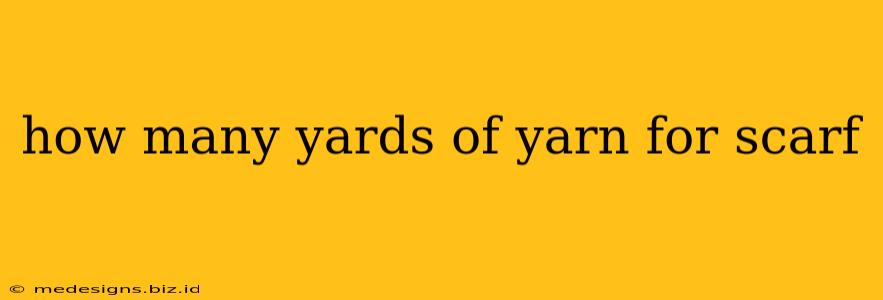Choosing the right amount of yarn for your next scarf project can feel daunting. Too little, and you'll run out before finishing; too much, and you'll be left with a hefty leftover stash. This guide breaks down how to accurately estimate the yarn needed for your scarf, ensuring a smooth and satisfying knitting or crocheting experience.
Factors Affecting Yarn Requirements
Several crucial factors influence how much yarn you'll need for your scarf. Getting these right is key to accurate estimation:
1. Scarf Dimensions: Length and Width
The most significant factor is the desired length and width of your scarf. A long, wide scarf will obviously require more yarn than a short, narrow one. Before you even start, measure out your ideal dimensions. Consider whether you want a snug, lightweight scarf or a bulky, warm one.
2. Yarn Weight: A Crucial Consideration
Yarn weight (also known as yarn thickness) dramatically impacts yarn consumption. Bulky weight yarn will produce a scarf quickly with fewer yards, while fingering weight yarn will take significantly more yardage to achieve the same size. Check the yarn label for its weight classification (e.g., fingering, sport, DK, worsted, bulky).
3. Stitch Pattern: The Impact of Texture
Different stitch patterns have varying yarn requirements. Intricate lace patterns generally use more yarn than simple stockinette stitch due to the extra yarn needed to create the open spaces. Similarly, cable patterns often require slightly more yarn than simpler stitches.
4. Yarn Fiber Content: Natural vs. Synthetic
Natural fibers like wool, cashmere, and alpaca can sometimes require slightly more yarn than synthetic options like acrylic due to their inherent properties. This difference is often subtle, but worth noting for precision.
Estimating Yarn Requirements: Practical Methods
There are several ways to estimate the yarn you'll need:
1. Using Yarn Weight and Gauge Swatches
The most accurate method involves creating a gauge swatch. This small sample allows you to determine how many stitches and rows you get per inch using your chosen yarn and needles/hook. Once you know your gauge, you can calculate the total number of stitches and rows needed for your scarf and then refer to the yarn label which will list the approximate yardage per 100 grams.
2. Referencing Free Patterns & Online Calculators
Many free knitting and crochet patterns include the yarn requirements in the description, which is a helpful starting point. You can also find online yarn calculators that take into account yarn weight, stitch pattern, and desired dimensions to estimate the required yardage. Always double-check these calculations since the accuracy depends on the provided information.
3. Consulting with Yarn Store Professionals
If you're unsure, visiting your local yarn store is always a good idea. Experienced yarn store staff can offer valuable advice based on your chosen yarn and project. They can help estimate yarn requirements and even recommend appropriate yarns for your chosen design.
Common Yarn Amounts for Different Scarf Sizes
Keep in mind these are estimates. Always check the yarn label and make a gauge swatch for more accurate results.
- Small, lightweight scarf (approx. 4" x 48"): 50-100 yards
- Medium-sized scarf (approx. 6" x 60"): 150-250 yards
- Large, bulky scarf (approx. 8" x 72"): 300-500 yards+
Remember: It’s always better to err on the side of caution and buy a little extra yarn. You can always use leftover yarn for other projects!
Conclusion
Determining the right amount of yarn for your scarf depends on several interlocking factors. By considering yarn weight, desired dimensions, stitch pattern, and utilizing the suggested methods, you’ll dramatically improve your chances of having just the right amount of yarn for your next cozy scarf project. Happy knitting or crocheting!
